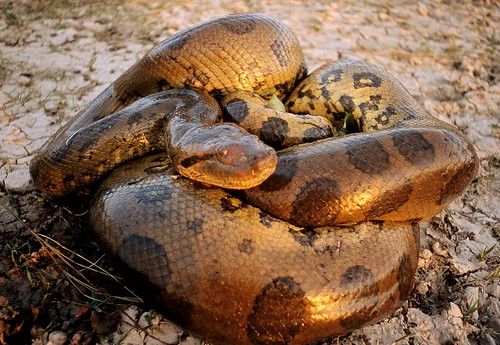Eunectes murinus or common name anaconda, common anaconda, water boa, green anaconda. is a non-venomous boa species found in South America. It is known as the largest of all snakes. Two subspecies are currently recognized, including the nominate subspecies described here.
The Green Anaconda is almost the world's longest snake reaching 6–10m (19.8 to 33 feet) long, rivaled only by the reticulated python (python reticulatus). Although there have been reports of snakes 15-20m being seen and tales of snakes ranging from 40-50m long, it is highly unlikely that these snakes could get any longer than 15m at the most. The heaviest one found weighed around 250kg. There is a $50,000 cash reward for anyone that can catch a snake 30 feet or longer, though the prize has not been claimed yet.
The color pattern consists of olive green background overlaid with black blotches along the length of the body. The head is narrow compared to the rest of the body, usually with distinctive orange-yellow striping on either side. The eyes are set high on the head, allowing the snake to see out of the water while swimming without exposing its body.
Anaconda, common anaconda, water boa, green anaconda.
Local names in South America include the Spanish term "matatoro," meaning "bull killer," and the Native American terms sucuri and "yakumama" in the Peruvian region of the Amazon, which means "mother of the water" in the language of the Amazonian Yakurunas or "water people".
The Green Anaconda is almost the world's longest snake reaching 6–10m (19.8 to 33 feet) long, rivaled only by the reticulated python (python reticulatus). Although there have been reports of snakes 15-20m being seen and tales of snakes ranging from 40-50m long, it is highly unlikely that these snakes could get any longer than 15m at the most. The heaviest one found weighed around 250kg. There is a $50,000 cash reward for anyone that can catch a snake 30 feet or longer, though the prize has not been claimed yet.
The color pattern consists of olive green background overlaid with black blotches along the length of the body. The head is narrow compared to the rest of the body, usually with distinctive orange-yellow striping on either side. The eyes are set high on the head, allowing the snake to see out of the water while swimming without exposing its body.
Anaconda, common anaconda, water boa, green anaconda.
Local names in South America include the Spanish term "matatoro," meaning "bull killer," and the Native American terms sucuri and "yakumama" in the Peruvian region of the Amazon, which means "mother of the water" in the language of the Amazonian Yakurunas or "water people".


No comments:
Post a Comment